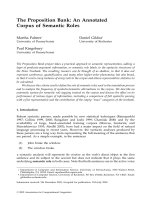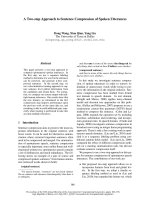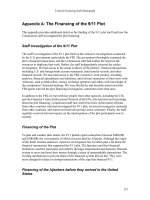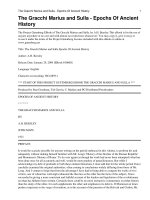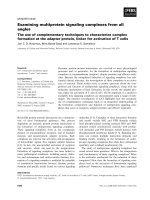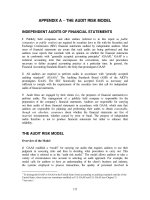APPENDIX A – THE AUDIT RISK MODEL INDEPENDENT AUDITS OF FINANCIAL STATEMENTS pdf
Bạn đang xem bản rút gọn của tài liệu. Xem và tải ngay bản đầy đủ của tài liệu tại đây (25.29 KB, 6 trang )
175
APPENDIX A – THE AUDIT RISK MODEL
INDEPENDENT AUDITS OF FINANCIAL STATEMENTS
1 Publicly held companies and other entities (referred to in this report as public
companies or public entities) are required by securities laws to file with the Securities and
Exchange Commission (SEC) financial statements audited by independent auditors. Most
users of financial statements are aware that such audits are being performed and that
auditors issue reports that conclude with an opinion on whether the financial statements
are in conformity with “generally accepted accounting principles” (GAAP).
1
GAAP is a
technical accounting term that encompasses the conventions, rules and procedures
necessary to define accepted accounting practice at a particular time. In general, the
Financial Accounting Standards Board is the body that promulgates GAAP.
2 All auditors are required to perform audits in accordance with “generally accepted
auditing standards” (GAAS).
2
The Auditing Standards Board (ASB) of the AICPA
promulgates GAAS. The SEC historically has accepted GAAS as necessary and
sufficient to comply with the requirements of the securities laws that call for independent
audits of financial statements.
3 Audit firms are engaged by their clients (i.e., the preparers of financial statements) to
perform audits. The management of a publicly held company is responsible for the
preparation of the company’s financial statements. Auditors are responsible for carrying
out their audits of those financial statements in accordance with GAAS, which state that
auditors are responsible for planning and performing their audits to obtain reasonable,
though not absolute, assurance about whether the financial statements are free of
material misstatement, whether caused by error or fraud. The purpose of independent
audits therefore is not to produce financial statements but rather to enhance their
reliability.
THE AUDIT RISK MODEL
Overview of the Model
4 GAAS establish a “model” for carrying out audits that requires auditors to use their
judgment in assessing risks and then in deciding what procedures to carry out. This
model often is referred to as the “audit risk model.” The model allows auditors to take a
variety of circumstances into account in selecting an audit approach. For example, the
model calls for auditors to have an understanding of the client’s business and industry,
the systems employed to process transactions, the quality of personnel involved in
1
To distinguish GAAP or GAAS in the United States from accounting or auditing standards outside of the
United States, these terms are sometimes modified as U.S. GAAP and U.S. GAAS (see Chapter 7).
2
See note 1.
176
accounting functions, the client’s policies and procedures related to the preparation of
financial statements, and much more. The model requires auditors to gain an
understanding of a company’s internal control, and to test the effectiveness of controls if
the auditor intends to rely on them when considering the nature, timing and extent of the
substantive tests to be carried out. For example, if controls over sales and accounts
receivable are strong, the auditor might send a limited number of accounts receivable
confirmation requests at an interim date and rely on the controls and certain other tests
for updating the accounts to year end. Conversely, if controls are not strong, the auditor
might send a larger number of accounts receivable confirmations at year end. The model
requires an assessment of the risk of fraud (intentional misstatements of financial
statements) in every audit.
5 Based on the auditor’s assessment of various risks and any tests of controls, the
auditor makes judgments about the kinds of evidence (from sources that are internal or
external to the client’s organization) needed to achieve “reasonable assurance.” On the
one hand, GAAS set forth numerous requirements or matters that auditors should
consider; on the other hand, the need to exercise audit judgment is embedded throughout
GAAS.
Technical Briefing About the Model
6 Statement on Auditing Standards (SAS) No. 47, Audit Risk and Materiality in
Conducting an Audit, essentially provides the high-level conceptual underpinning for the
audit risk model, but the concepts in the model permeate GAAS. For example, the model
directly influences audit sampling, which is the application of an audit procedure to less
than 100% of the items in a given population for the purpose of evaluating some
characteristics of the population.
7 Audit risk (AR) is the risk that the auditor may unknowingly fail to appropriately
modify his or her opinion on financial statements that are materially misstated. Audit risk
is the product of the following three interrelated factors:
IR = Inherent risk (the risk that an assertion is susceptible to a material
misstatement, assuming there are no related controls)
CR = Control risk (the risk that a material misstatement that could occur in an
assertion will not be prevented or detected on a timely basis by the entity’s
internal control)
DR = Detection risk (the risk that the auditor will not detect a material
misstatement that exists in an assertion)
8 Thus, the “mathematical” depiction of the audit risk model in simple terms is AR =
IR x CR x DR. Despite the precision implied by rendering the model in mathematical
terms, in reality it is highly judgmental. The objective in an audit is to limit audit risk
(AR) to a low level, as judged by the auditor.
177
9 Essentially this objective is accomplished as follows. Auditors are required to assess
inherent risk (IR) and control risk (CR) along a spectrum. Often in practice this
assessment is reduced to three levels: maximum risk, moderate risk or low risk (or similar
terms, such as high, medium or low risk). These assessments are complex matters to
carry out, and GAAS set forth a number of requirements on how to accomplish them at
both the financial statement level and the individual account balance or class of
transactions level. GAAS also contain a specific requirement that, if control risk is to be
assessed at less than the maximum level, the auditor must test the effectiveness of
controls to support that assessment. A maximum risk assessment (i.e., 100%) means that
the auditor believes controls are unlikely to pertain to an assertion or are unlikely to be
effective, or the evaluation of their effectiveness would be inefficient. In all cases, the
auditor is permitted to “default” to a maximum risk assessment for inherent or control
risk.
10 The importance of the assessments of inherent and control risk is highlighted by their
effects on detection risk (DR). The effects can be depicted in mathematical form by the
equation DR = AR / (IR x CR). The auditor mitigates or compensates for the assessed
levels of risk by designing and performing procedures to detect material misstatements.
The greater the inherent and control risks, the lower the detection risk needs to be,
resulting in “more” procedures (“more” includes their nature and timing as well as their
extent) that the auditor would need to carry out. At the end of the day, the objective is to
limit audit risk to an appropriately low level, thus enabling the auditor to achieve
reasonable assurance that the financial statements are free of material misstatement.
11 Some added observations about what the audit risk model contains and does not
contain are worthy of discussion. First, the model subsumes the concept of “materiality.”
Auditors do not have to concern themselves with every possible misstatement of a
financial statement that might occur. Consequently, the concept of materiality enters into
the risk assessment process, and the selection of the nature, timing and extent of the audit
procedures is an integral part of the model. Furthermore, the model calls for auditors to
make “fraud risk” assessments that encompass attributes of both inherent and control
risk.
12 Lastly, the auditor also is exposed to risks that are not embraced in the audit risk
model. For example, auditors may be exposed to loss or injury to their professional
practice from litigation, adverse publicity or other events arising in connection with
financial statements they audited and reported on. This exposure is present even though
the auditor has performed the audit in accordance with GAAS and has reported
appropriately on the financial statements. Even if the auditor assesses this exposure as
low, the auditor is not permitted to perform less extensive procedures than otherwise
would be appropriate under GAAS. The “risks” that fall outside of the audit risk model
generally are referred to as “engagement risk,” “client risk” or “client continuance (or
acceptance) risk.”
178
Historical Perspective of the Model in GAAS
13 The audit risk model is codified in GAAS (although not by name), primarily in SAS
No. 47. The ASB issued SAS No. 47 in 1983, and it was amended in 1997 by SAS No.
82, Consideration of Fraud in a Financial Statement Audit. Prior to SAS No. 47, many
auditors employed some of the model’s concepts in practice, albeit they were not
explicitly codified and embedded in GAAS. There is, however, no clear record of exactly
what practice was in this area prior to SAS No. 47. Generally, it is believed that, while
auditors’ judgments entered into the audit process, many auditors employed “procedural”
approaches that were not fully supported by strict conceptual underpinnings. In other
words, audits tended to be conducted using a variety of substantive testing approaches
with less reliance on judgments about risk. Testing of internal control, primarily by
testing individual transactions, was common and sometimes extensive.
14 Since 1984, auditors have been required to follow SAS No. 47; in other words, they
have been required to employ the audit risk model. Notwithstanding this requirement,
anecdotal and other evidence indicates that many (but by no means all) audits continued
to be performed using substantive testing approaches with little or no attention paid to the
results of the risk assessments called for by the model. This phenomenon perhaps is
facilitated by the fact that the model permits “defaulting” to an assumption that risks are
at a maximum level.
15 Over time, however, audit firms began to evaluate both the effectiveness and
efficiency of their audits. The sheer volume of transactions processed by client
organizations, the fast pace of technological developments affecting client organizations
and audit firms alike, and economic constraints on the ability of audit firms to recover
rising costs were influential drivers in these evaluations. They led some firms to conclude
that many audits were being conducted without sufficient consideration being given to
the risk assessment process and that they consequently lacked in both effectiveness and
efficiency. Some firms responded by making important changes to their audit
methodologies. Furthermore, changes to audit methodologies continue to be made by
firms and some of those changes are highly significant.
AUDIT FIRM METHODOLOGIES
16 While all audits of financial statements of publicly held companies are required to
comply with GAAS, audit firms are at liberty to design their audit processes or
methodologies in whatever manner best suits their needs so long as the processes or
methodologies result in audits that comply with GAAS. Historically, audit firms have
adapted their processes or methodologies in response to such matters as changes in
business or industry conditions, changes in clients’ systems or use of technology, and
new or changed requirements of GAAS or GAAP.
179
17 Auditors are guided in many ways by their firms’ processes or methodologies – for
example, how personnel are assigned to engagements, how they are supervised and their
work is reviewed, the way audit working papers are prepared (e.g., by electronic means
or otherwise) and the nature and extent of documentation retained in the working papers.
For multi-location audits, including those for which work is to be performed outside of
the United States, the processes or methodologies guide how that work is carried out and
by whom, and how it is reviewed. Included in the processes and methodologies are
policies and guidance on matters for which consultation within the audit firm is required
or advisable, and on other quality control matters.
18 Audit firms also take into consideration their clients’ expectations, such as
expectations that the auditor will inform them of matters that might benefit their
businesses. Clients’ expectations often go well beyond GAAS requirements for
performing financial statement audits. Auditors respond to those expectations by
providing information or services beyond the financial statement audit, either separately
or as an integral part of their audit processes and methodologies.
180



